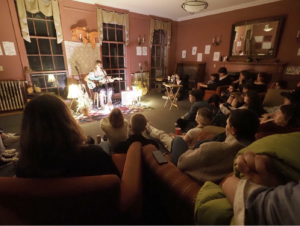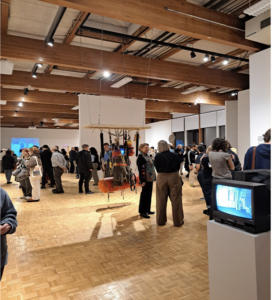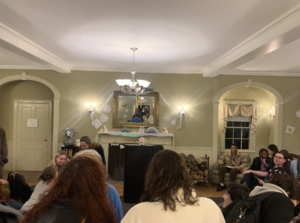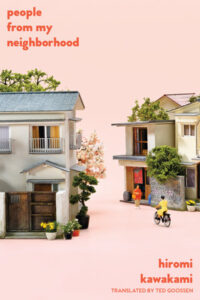Cottagecore— an internet aesthetic that has gained traction during the pandemic and proliferated into a global sensation— can be identified through a set of clearly defined visual codes despite the diversity of the environment it fosters; fresh-baked and hand-made sourdough loaves with floury spliced tops, long dresses spotted with strawberries or white long-sleeved button-ups with frilled collarbones, fields of wildflowers and overgrown grass with animals intertwined with stems and petals, orange mushrooms at the base of a fresh-bloomed tree. “It’s like Animal Crossing, but in real life,” writes Emily Kellum from Belmont, Massachusetts in an email to New York Times reporter Isabel Slone. But the aesthetic is far from a harmless, bucolic corner of digital culture; its ability to sublimate our escapist desire into a glorified, pastoral, and fictive rural landscape deludes us into believing that we can truly escape the troubles that surround us.
Cottagecore exists almost entirely online. In the form of images, content creators can create idyllic landscapes through images and videos that evoke rich, illustrious “vibes” of comfort and warmth. Slone describes this digital landscape as a patch of grass in the “dense thicket of the internet…where dappled sunbeams peek through the leaves, resting fawns doze about, a troop of woodland mushrooms grows underfoot, and a brook faintly burbles in the distance.” Beyond the natural imagery lies a handmade, grassroots self-sufficiency and tenderness, with rustic cottages, knit blankets and cloth, homegrown produce and fresh-baked raspberry scones with laundry drying in a backyard closed off by a stone fence. “It’s the backdrop of a budding aesthetic,” writes Slone in an article for the Times in 2020, where “tropes of self-sufficiency converge with dainty décor to create an exceptionally twee distillation of pastoral existence.”
Though the first traces of the aesthetic date back to 2018 Tumblr, the desire to return to a simplified rural lifestyle is not new. In 1777, Marie Antoinette, fraught by royal life, yet deeply committed to maintaining its comforts, had a town built for her just outside of the Palace of Versailles. “Inspired by the naturalistic paintings of the time—something of a Tumblr board of her own,” writes Emma Bowman for NPR. Antoinette had “commissioned the construction of a rustic retreat,” a “string of cottages [that] gave her the feeling of escapism not far from the palace grounds.” Joe Vaughn—digital editor of the Museum of English Rural Life—describes Antoinette’s town as a “pastoral knowledge for a simple life [that] is simply not reflective of lived experience.”
But there are very real benefits to adopting this simplicity. Antoinette, for instance, was able to avoid the labor of rural life while maintaining her social image. The webpage for the Chateau de Versailles ensured that consumers looking for tickets for guided tours or wedding venues knew that Antoinette was not immersing herself in the rural lifestyle. “The queen actually used the hamlet as a place for relaxing walks, or to host small gatherings;” a form of social currency and posturing that detached her from the responsibilities of royalty with a comfortable distance from the impoverishment of a disenfranchised French lower class. In a tweet, the Museum of English Rural Life notes that “Rural cottages were also a far cry from the way in which Marie Antoinette’s expansive royal cottage in the hamlet was presented.”
When I look up “Marie Antoinette” on Pinterest, one of the first images I see is a still from the titular movie directed by Sofia Coppola in 2006. In the image, four women lounge in a meadow on their knees in the tall grass and a spread of dainty, pink flowers sprinkle through the field. The flowers match the dresses of the two women to the left and right of Marie Antionette— played by Kirsten Dunst— who wears a long white dress with frills around her shoulders as she reads from a yellow-paged red-hardback book with gold etchings in the spine. Her blonde hair spills over her head. A woman in yellow—face covered by a wide hat over rust-red hair—folds her hands in her lap and looks intently at Antoinette.
Like Antionette in the film, my friend and I were occupied by this desire to lounge in the field in summer-bliss drenched in sunlight, totally detached from the infringements of an industrialized outside world during our brief picnic at the empty elementary school. Admittedly, however, I would rather see cottagecore than live it; my moment of idyllic bliss was disturbed by a torrential downpour— but on Pinterest, I can scroll through the images of lambs and baby goats, baskets of lavender and fresh-baked pies, white frilly dresses, and floral-patterned tea sets from a comfortably delicious distance.
Cottagecore represents a life I want to have; detached from direct deposit and my 2009 Toyota Corolla with the squeaky serpentine belt and overdue inspection. I can inhabit idyllic tranquility, where summer never ends, and rain is far from common. If I change my mind, I try a different search (perhaps Twilightcore, a Gothic twist on the Pacific Northwest and its fictional vampires, or maybe cryptidcore, an X Files-esque aesthetic based on urban legends.) From the comfort of digital distance from the subject, I can inhabit and participate in any lifestyle by coveting its aesthetic; by deepscrolling through #cottagecore, I am enthralled and seduced by images of silent, blissful pleasure, my senses drunk with an otherwise unattainable atmosphere.
I am not Marie Antoinette—and neither is Kirsten Dunst; my hamlet is constructed not outside the Palace of Versailles, but rather, in the digital sphere, the same space cottagecore—as Slone writes—“would rather eschew.” I delude myself into the escape. In the romanticized, bucolic visual phenomena of cottagecore, the abandonment of modernity occurs in a nearly perfect illusion—social media becomes a locus through which I sublimate a desire for another, antimodern, and better lifestyle.
Content creator Cristina [LastName]—known by her handle @swannandtheberries—considers herself to be a “cottagecore dreamer” according to her Instagram bio. With over 123,000 followers on Instagram and another 108,000 on TikTok, Swann has been providing her viewers with cottagecore images, videos, and products. “When I was little,” she writes in a blog post for her small business Nour & the Merchant, “My mom used to read Lord of the Rings to me as a bedtime story. My mother was beautiful, with long, thick hair and an eye for all things graceful. She used to make everything so mysterious when she talked about it. Because of her I’ve always been fascinated by fairytales.”
When her mother died, however, this feeling of whimsy had suspended. “She was gone and the little mountain town I grew up in felt emptier.” The idyllic Victorian-esque childhood surrounded by stories and wonder, loving mothers with thick hair and alluring tales, had—for a moment—shuddered to a close. But her content became a way to reconnect with this relationship; “the mountains,” she writes, “the forest, the snow, the wind…everything was a reminder of her essence. Since then, I wanted to re-create a world where dragons really existed, and we could reach far away kingdoms. So, I decided to start my own company and design something that could allow people to live in a fairytale. The world can sometimes be cruel, raw, dull, or even lacking elegance and grace. But what is truly magical is to acknowledge it all and still be able to dream.”
The fantasy has grown into far more than a shrine to a dead mother; it has become her entire digital life. In a TikTok from February 26th, 2022, Swann runs in slow motion away from the camera through a clearing in the woods. Her bright red hair bobs left and right as she bunches her striped beige dress in her hands. Over her billowing, white button-up shirt, an emerald waistcoat; a large matching bow rests elegantly on her head, a real-life Anne Shirley all grown up (Swann, now twenty-nine, is far from childhood.) The video plays over “September Song” by Agnes Obel, a light, nostalgic, yet melancholy song, fitting for a young girl in the woods running towards an adventure. Her life—in a digital sense—is dictated by this fictive imagery; we know Swann, not as herself, but as the woman plucked out of a 19th-century Romantic novel, a fantasy story untainted by a Dark Force’s™ influence.
The fairytale lifestyle is, undoubtedly, alluring. Heroism and beautiful, elegant creatures poised against the dark ugliness of wicked monsters; the opening scenes of The Fellowship of the Ring alone are intoxicating—the rolling hills of the Shire and sweet, nostalgic music played from a wooden pipe with images of barefooted townspeople gardening, eating, cooking, lounging before a night of drinking and games. “By some chance,” Tolkien writes in his book The Hobbit while describing the moment Gandalf the Grey pays Bilbo Baggins a visit on his doorstep, “in the quiet of the world, when there was less noise and more green, and the hobbits were still numerous and prosperous, and Bilbo Baggins was standing at his door after breakfast smoking an enormous long wooden pipe.”
Cottagecore, a digital Shire, acts as that last bit of quiet with “less noise and more green,” a sunny patch of grass within a thicket of trees where we can live out the kind of childhood innocence nostalgia captures. If we have the money and the time, we can live the way Swann lives; but it is enough to delude ourselves by simply romanticizing the rural landscape, sublimating our desires through the content creators with the ability to physically attain the lifestyle.
Emma Sweat started her blog shortly after her son Ezra died in 2012 due to a placental abruption while she was in labor. Sweat, a “lover of all things deep and meaningful and beautiful,” found herself struggling with the grief, and turned to blogging as an outlet alongside her devotion to God. “It was the hardest experience of my life,” she writes. “I realized how much my faith was in my bones when I was weeping and the line of a hymn or verse my pastor repeated often would come to mind and wash over the pain.” Her blog grew into a small, “How To” business called Intentional Home Living, a place where she can write guides for people like her looking to pull away from the harshness of the life they live. “I want to share my love for creating beauty in our homes and giving it life through traditions and memories. I want to share my passion for nourishing my family with slow, real food from scratch.”
Her Instagram account reflects this desire for simplicity and transcendence. In April 2022, she posted a confessional guide for her followers. “We are so overstimulated,” she writes in the caption of a video post of her and her children rolling down hills, picking ripe apples or fresh flowers from their garden during golden hour:
“Too much input. Too much information. It’s more than we are meant to take in. I find when I’m in that state of overwhelm, nature brings me back. It centers me. I see that there is purpose all around me as I watch the simplicity of a mother bird searching the ground to find food for her babies. Squirrels frolicking from branch to branch in the sunshine. Plants bursting forth from the earth to fulfill their intended purpose. Just because we can do everything with all the information we have in our modern world, doesn’t mean we should.”
Below her profile picture—an image of Sweat drinking tea at a dark wood table in a white Victorian nightgown next to a wicker basket with a lace handkerchief draped over the side—she summarizes her business, blog, and life as “#cottagecorestyle,” advertising herself as an aesthetic.
In the home décor section of her blog, an entire page is dedicated to instructional guide-posts for how to achieve the cottagecore look in your own home. Headlines like “Easy Cottagecore Faux Flower Arrangements,” “Thrifty and Cozy Cottagecore Laundry Room,” and “Easy DIY Cottage Style Curtains—Mostly Thrifted!” spread over the white webpage with large images of cozy rooms with dim, burnt-toast gold lights and stark white walls with plants in pots and vases next to apple baskets, wooden mirror frames, and rustic, wicker baskets. Nearly a year ago, on April 16th, Sweat published her guide for living the cottage life titled “Cottagecore Style Aesthetic: How to Create It.”
Her instructions reflect some of the core idylls the aesthetic covets. The post opens with a simplistic list of the key points in acquiring the cottagecore life: “Create collections in your home. Gather books and stack them or group pitchers filled with wildflowers together;” “Incorporate vintage and antique furniture. Cottagecore is about creating a lived-in, relaxed, old-world feel;” “Value nostalgia;” “Bring nature indoors. Nature is king in cottagecore style design;” “Floral prints are huge in cottagecore. Start small by using wallpaper on an accent wall or only the top half of a larger wall.” But these tenets become somewhat uncanny as she drifts away from products and objects to ideas and desires. “Cottagecore is a romanticized version of life lived in a peaceful cottage in the countryside,” she writes: “Think fairy tales and pastoral English views. Fields of wildflowers and beautiful meadows. The home design aspect of cottagecore is essentially a combination of old-world English cottage and authentic farmhouse lifestyle.”
Her article ends with the aspects she is most drawn to. After the death of her son, and the turn toward God and slow living away from the stimulus of a modern world, it is no wonder that cottagecore is “a culmination of so many things that bring [her] joy.” She writes that “it is simply an old-fashioned way of life. Less noise. More quiet. Creating. And Nature. People who lived the original cottagecore life in history, without all the distractions of our modern day, had free mental space to enjoy life’s simple pleasures.” For Sweat, we can find peak happiness in total abandonment of the contemporary landscape, with its “overload of advertisements, information, and social pressures.” And if we are struggling to reach the enlightenment Sweat has found, if we “feel the same way about slowing down and appreciating the home,” we can join her “Home Living Community,” to be notified of latest content and recipes with monthly emails from Sweat with her thoughts and reflections.
Romantic, rural living, effortless transcendence through the natural world: Sweat embraces the cottagecore lifestyle, and calls on others to covet its slowness, its tranquility, to join her in abandoning modernity; and yet, she does so through the digital landscape. Eschewing the capitalist machine and its advertisements, she makes one of her own, broadcasting escapism without fully escaping herself, selling the fairytale while hiding from her entanglement with the system she rejects.
She is not alone. Lauren Molloy, a young woman who spoke with [KASHI SOURCE] feels that cottagecore presents an alternative mode of living in the rigors of modernity. “In our fast-paced society,” she says, “the process of making, doing, feeling connected, has virtually been eliminated. We love the thought of slowing down, feeling connected, and having the experience be meaningful.” Phoenix Tweedy from Forest Grove, Oregon, saw this escape in a similar vein as Sweat after an active shooter attacked and killed one of her classmates at Reynolds High School in 2014. She dropped out shortly afterward, the trauma from the incident being nearly unbearable; therapies, medication, treatment—nothing healed her. Until cottagecore. “Instead of sleeping all day,” she says, “I could try to bake something.” Compared to the tempest of American society—Tweedy specifically cites having to find a job, the capitalist-patriarchy of the United States, the rise of Trumpism following the 2016 election, and an overall rage at growing violence and unrest—cottagecore becomes a worthy substitute, where suffering is nonexistent, “an afterthought.” Abandonment penetrates the cottagecore aesthetic, becoming its main selling point for young people coping with a less-than-pleasant modern world.
Escape the contemporary, its stimulus and suffering, its quick-paced money-driven masculine designs, its brazen machine and choking numbness—escape into the country, the pastoral rural universe; bake bread and garden in sun-drenched meadows and fairy-tale forests. But there is no escape. In order to access cottagecore, we must rely on the same system it seeks to abandon; we must buy the right clothes, furnish our homes with the right décor, the right plants, colors, and objects to assimilate into a community that exists entirely within the Internet. Abandonment is an illusion; cottagecore promises escape, and yet, in actuality, what results is a kind of anesthetic complacency profiting off of an idealized, romantic rural paradise.
Solarpunkwitchcraft criticized cottagecore on Tumblr in a QandA post responding to an earlier user. On a lime green webpage, the anonymous asker expressed concern towards Solarpunkwitchcraft’s anti-cottagecore stance. “Cottagecore comes from a place where there is no ethical consumption under capitalism. We’re doing what we can.” This is somewhat comforting to me; “we’re doing what we can” implies a self-awareness that does not rely on escapist fantasy, and instead responds to a precarious modernity. But this means the asker admits that the selling point of cottagecore is an illusion. “We’re doing what we can” reveals the difficulty of the escape and the fragile maintenance of its fictive walls enshrining a nonexistent innocence and sanctuary; in Solarpunkwitchcraft’s response, the veil becomes especially strained.
According to Solarpunkwitchcraft, cottagecore “represents a desire to try and escape the system, to isolate yourself from everything bad. But you can’t. Because, in America at least, that cottage, that commune will be on stolen Indigenous land. And because, beyond the walls of your idyllic escape, there will still be racism, and capitalist exploitation, and violence, and escaping won’t solve those problems.” As I read this, I realized there is an even more profound delusion occurring than the total surrender to the cottagecore lifestyle: our participation in the aesthetic hinges on consuming only the images of cottagecore. We sublimate our desire to escape by watching others do so online—with apparent success—and for the most part, that’s enough; as an anesthetic, cottagecore succeeds, the romantic deliciousness of its carefree, handmade, sun-drenched eternal-summer atmosphere seductive enough to keep us a bit more hopeful, a bit more complacent.
Kyle Chayka, a media journalist for the New Yorker, uses the word “vibes” (which has been acclimated to the internet language to describe an inarticulate feeling or mood) to provide an architecture for this atmospheric identification with an aesthetic. He writes that “users mold and document their non-virtual lives in the image of these labels. The vibe moves from the Internet into the physical world and back again, a wavelength on the radar of our perceptions.” The digital becomes as tangible as the real as we respond emotionally to media; when I watch TikTok’s from cottagecore creators—which I often do—I am emotionally affected, as though they were six-second to three-minute film vignettes indulging my senses, flashes of a fantasy right in front of me, attainable yet slippery, delicious yet ephemeral. I am anesthetized enough to go to class, or fall asleep, with images of fresh-baked loaves of bread and muffins, pristine, youthful sheep with clean white wool and ducklings splashing in the tin tubs used for watering cattle.
Those looking to abandon capitalism for a romantic, self-sufficient lifestyle can do so by shaping their physical lives around a digital one. For $15.67 on Amazon, one can purchase the book “Escape into Cottagecore: Embrace Cosy Countryside Comfort in Your Everyday.” Ramona Jones wrote the teal blue book adorned with flowers and tea kettles, pink cottages and ferns with a steaming fresh-baked pie and honeybees populating the cover, promising to give the reader the opportunity to “find happiness in the natural world, be fully present where you are and free yourself from the expectations of others. Embrace a more peaceful life with cottagecore – a soft, fairytale world that combines traditional comforts with a modern existence to create a sense of magic and retreat.”
In order to indulge in the escape, we have to likewise give in to the very things it seeks to enshrine us from; we buy and sell (as participants in cottagecore often make their goods available for purchase) the products that translate to the aesthetic, the “vibes” that Chayka describes as bearing influence over our desires, digital sublimations that swell into decisive lifestyles. There is no escape; the spoils of cottagecore delude us long enough to make us feel closer to the idyll, to make us feel that our purchases, our participation in modernity, can allow us to abandon a tumultuous present. But in optimizing cottagecore, we are entrapped in another circuit of the machine entirely; rather than escape, we are just as docile as we were before.








Be First to Comment